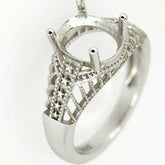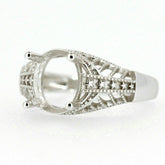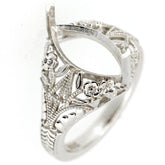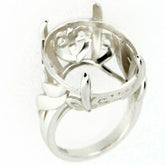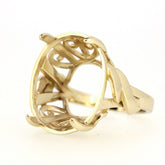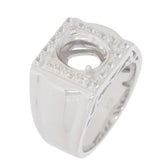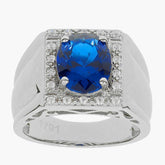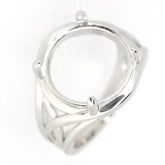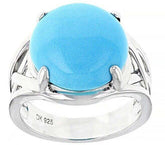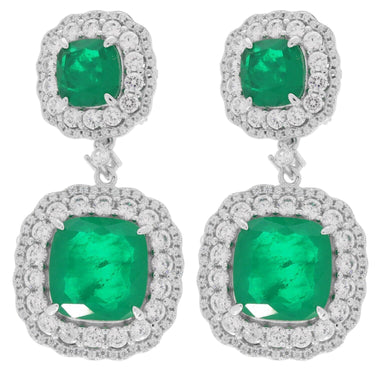How to Clean Sterling Silver Jewelry at Home: My Easy DIY Guide
Sterling silver jewelry? I love how it instantly adds a bit of class to any outfit! But, you know, the way it tarnishes can be a real pain. The good news is, you don't always need to run to a jeweler to get your favorite pieces looking brand new again. I’ve put together this guide to show you some simple, effective, and budget-friendly ways you can clean your sterling silver jewelry right at home.
Whether you're just seeing a little bit of tarnish or dealing with a piece that's gone seriously dark, I'm going to show you how to use stuff you probably already have, like baking soda, aluminum foil, and some mild soap, to bring back that original sparkle. Plus, I'll share some tips on how to keep tarnish away in the first place, how to store your jewelry properly, and what mistakes to avoid. That way, your silver can stay shiny for years!
Quick Summary:
- Soap and Water: This is your go-to for a quick, gentle clean when you just see a little tarnish or want to keep things looking good regularly.
- Baking Soda and Aluminum Foil: When tarnish is heavy, this method is like the superhero that swoops in to save the day.
- Vinegar and Baking Soda: Want something natural? This mix is a pretty cool way to dissolve tarnish without harsh stuff.
Last Updated: October 26, 2023
Table of Contents
- Understanding Sterling Silver and Tarnish
- Essential Tools and Materials for Cleaning Sterling Silver
- The Soap and Water Method: Gentle Cleaning for Everyday Use
- The Baking Soda and Aluminum Foil Method: Deep Cleaning for Heavy Tarnish
- The Vinegar and Baking Soda Method: A Natural Cleaning Solution
- Polishing Your Sterling Silver: Restoring Shine and Luster
- Preventing Tarnish: Tips for Long-Term Care
- Common Mistakes to Avoid When Cleaning Sterling Silver
- Special Considerations for Gemstone and Antique Jewelry
- DIY vs. Professional Cleaning: When to Call an Expert
- Top Products and Tools for Sterling Silver Care
Understanding Sterling Silver and Tarnish
Before we jump into how to clean, I think it’s helpful to understand what sterling silver actually is and why it gets all tarnished. Knowing the basics will help you pick the right cleaning method and stop tarnish from coming back so quickly.
What is Sterling Silver?
So, sterling silver isn't pure silver. It's actually a mix – 92.5% pure silver and 7.5% other metals, usually copper. They add those other metals to make the silver stronger and more durable for making jewelry. Pure silver is just too soft; it would scratch or bend super easily if you wore it every day. That’s why you'll often see ".925" stamped on sterling silver – it's a mark of that 92.5% purity.
Why Does Sterling Silver Tarnish?
Okay, here’s the deal: sterling silver tarnishes because it reacts with sulfur stuff floating around in the air. It's a chemical thing called oxidation, and it makes silver sulfide, which looks like a dark or black layer on your jewelry. Things like humidity, pollution, and even stuff like perfumes, lotions, and certain foods can speed up this tarnishing process. Understanding this whole process is honestly the key to getting rid of that tarnish effectively.

How to Identify Tarnish on Your Jewelry
Basically, tarnish looks like a dull, dark, or black coating on the surface of your silver jewelry. It might be just a light haze, or it could be a thick, obvious layer. Unlike rust, tarnish doesn't eat away at the metal, but it can make your jewelry look kinda old and not so pretty. If you check your pieces regularly, you can catch the tarnish early, which makes it way easier to clean off.
Essential Tools and Materials for Cleaning Sterling Silver
Having the right stuff ready to go makes cleaning your silver yourself a whole lot easier and works better too. Most of these things are probably already hanging around your house, which is awesome because it keeps things cheap and easy.
Common Household Items for Cleaning
- Mild Dish Soap: This is your go-to for gently getting rid of dirt and oils.
- Baking Soda: It’s a mild abrasive, so it helps lift tarnish without scratching your silver.
- Aluminum Foil: You’ll need this for the cool chemical reaction in the baking soda method.
- White Vinegar: A natural acid that helps dissolve tarnish. Pretty neat!
- Soft Cloths: Microfiber cloths are perfect for polishing and drying your jewelry.
Specialized Tools for Jewelry Care
- Soft-Bristled Brush: An old toothbrush is great for getting into all those little nooks and crannies.
- Polishing Cloth: These are specially made for polishing silver and bringing back that shine.
- Jewelry Cleaning Solution (Optional): You can buy these for extra cleaning power, but honestly, the DIY methods often work just as well.
Where to Find These Materials
You can find most of this stuff at your local grocery store, drugstore, or even a hardware store. Polishing cloths and special jewelry cleaning solutions? Check out jewelry stores or online. Using everyday items is how you get professional-looking results without spending a ton of money.
Which Method is Right for You?
Figuring out the best cleaning method really depends on how bad the tarnish is and what kind of jewelry you're dealing with. Here’s a little table to help you decide:
| Method | Best For | Time Required | Materials Needed | Caution |
|---|---|---|---|---|
| Soap and Water | Light Tarnish, Regular Cleaning | 15 minutes | Dish soap, water, soft cloth | Safe for all jewelry types |
| Baking Soda and Aluminum Foil | Heavy Tarnish | 20 minutes | Baking soda, aluminum foil, boiling water | Avoid on gemstones and oxidized finishes |
| Vinegar and Baking Soda | Moderate Tarnish, Natural Cleaning | 25 minutes | Vinegar, baking soda, soft cloth | Avoid on porous gemstones |
The Soap and Water Method: Gentle Cleaning for Everyday Use
The soap and water method is awesome for keeping up with your silver jewelry and getting rid of light tarnish. It’s super gentle, so it won’t hurt any delicate pieces you might have.
Step-by-Step Instructions
- Mix the Solution: Grab a small bowl and mix a few drops of mild dish soap with some warm water.
- Soak the Jewelry: Drop your silver jewelry into the soapy water and let it hang out for about 5-10 minutes.
- Scrub Gently: Use a soft toothbrush to gently scrub off any dirt or light tarnish. Don’t forget those tricky spots!
- Rinse it Off: Rinse your jewelry really well under warm, running water to get rid of all the soap.
- Dry and Polish: Use a soft cloth to dry your jewelry super well. Then, grab a polishing cloth to bring back that shine!
Before & After:

Tips for Best Results
- Use distilled water if you can; it helps avoid those annoying mineral spots on your jewelry.
- Make sure you’re using a gentle soap without any harsh chemicals.
- Dry your jewelry right away after rinsing to avoid water spots.
When to Use This Method
This is perfect for jewelry you wear every day and just needs a little freshening up. It’s also great for pieces with delicate stones or fancy designs that could get damaged by stronger cleaning stuff. If you clean your jewelry with soap and water regularly, you can stop tarnish from building up too much.
The Baking Soda and Aluminum Foil Method: Deep Cleaning for Heavy Tarnish
If your silver has a serious case of tarnish, the baking soda and aluminum foil method is your best bet. It uses a chemical reaction to lift the tarnish off without you having to scrub like crazy.
How the Chemical Reaction Works
Okay, so when you mix baking soda, aluminum foil, and hot water, something cool happens: it's called ion exchange. The tarnish (which is silver sulfide) turns back into silver, and the sulfur joins up with the aluminum foil. Want to know more about the science behind this? Check this out. It’s basically like magic – the tarnish disappears without any harsh chemicals or rough scrubbing.
Step-by-Step Instructions
- Get Ready: Line a glass or ceramic bowl with aluminum foil, making sure the shiny side is facing up.
- Add Baking Soda: Toss in 1-2 tablespoons of baking soda into the bowl.
- Pour in Hot Water: Pour enough boiling water into the bowl so it completely covers the jewelry.
- Submerge the Jewelry: Put your silver jewelry in the bowl, making sure it's touching the aluminum foil.
- Wait a Bit: Let it sit there for 5-10 minutes. You should see the tarnish moving from the jewelry to the foil.
- Rinse and Dry: Take the jewelry out, rinse it really well with warm water, and dry it with a soft cloth.
- Polish It Up: Use a polishing cloth to bring back the shine.
Step-by-Step Visual Guide:

Before & After:

Safety Precautions
- Do this in a place with good airflow because the chemical reaction can smell a bit sulfur-y.
- If your jewelry has delicate gemstones, skip this method. The heat and chemicals might damage them.
- Don’t use this on jewelry that has an oxidized finish – it’ll remove that intentional dark look.
Have you tried the foil method before? I'd love to hear how it went for you in the comments!
The Vinegar and Baking Soda Method: A Natural Cleaning Solution
If you're looking for something that's good for the environment, the vinegar and baking soda method is a great pick. It combines the gentle scrubbing power of baking soda with the acid in vinegar to dissolve tarnish.
Benefits of Using Vinegar
Vinegar is a natural acid that helps break down tarnish without any harsh chemicals. Plus, it's easy to find and doesn't cost much, which is always a win.
Step-by-Step Instructions
- Make a Paste: Mix 1/2 cup of white vinegar with 2 tablespoons of baking soda until it forms a paste.
- Apply the Paste: Put the paste on your tarnished silver jewelry using a soft cloth or toothbrush.
- Scrub Gently: Gently scrub the jewelry, paying extra attention to the really tarnished spots.
- Rinse Well: Rinse the jewelry under warm water to get rid of all the paste.
- Dry and Polish: Dry the jewelry with a soft cloth, then use a polishing cloth to bring back that shine.
Before & After:

When to Avoid This Method
Don’t use this on jewelry with gemstones that are porous because the vinegar can mess them up. Also, be careful with jewelry that has lots of tiny details – the paste can be hard to get out of those little crevices.
Polishing Your Sterling Silver: Restoring Shine and Luster
After you've cleaned your silver, polishing it is super important to bring back that original shine. There are a few different ways to polish, depending on how much shine you want.
Using a Polishing Cloth
A polishing cloth is a simple way to keep your silver jewelry looking shiny. These cloths have special polishing stuff in them that gently gets rid of tarnish and brings back the luster.
- How to Use: Just rub the jewelry with the cloth, using a bit of pressure. Focus on the parts that look dull or tarnished.
- Why it's Great: Polishing cloths are safe for most jewelry and you can use them regularly to stop tarnish from building up.
Applying Silver Polish Cream
Silver polish cream gives you a deeper clean and is perfect for pieces with heavy tarnish. These creams have mild abrasives that remove tarnish and bring back the shine.
- How to Use: Put a little silver polish cream on a soft cloth. Gently rub it onto the jewelry in small circles. Rinse the jewelry really well with warm water and dry it with a clean cloth.
- Why it's Great: Silver polish creams can get rid of tough tarnish and make your jewelry look brand new.
DIY Polishing Paste Recipes
If you're into natural stuff, you can make your own polishing paste with things you probably already have.
- Baking Soda Paste: Mix baking soda with a little water to make a paste. Put it on the jewelry and gently rub it with a soft cloth. Rinse well and dry.
- Toothpaste: Yep, regular (non-gel) toothpaste works as a mild abrasive. Put a little on a soft cloth and gently rub the jewelry. Rinse well and dry.
Preventing Tarnish: Tips for Long-Term Care
Stopping tarnish before it starts is the best way to keep your silver jewelry looking great. Here are a few easy tips to keep tarnish away and clean less often.
Wearing Habits That Reduce Tarnish
- Keep Away From Chemicals: Take off your jewelry before you go swimming in a chlorinated pool, use cleaning stuff, or put on lotions, perfumes, or hairspray.
- Wear it Often: Surprisingly, wearing your silver jewelry can actually help stop tarnish. The friction from wearing it helps keep the surface clean.
- Wipe it Down: After you wear your jewelry, wipe it with a soft cloth to get rid of any oils or residues.
Proper Storage Techniques
- Store in a Dry Place: Humidity makes tarnish happen faster, so keep your jewelry in a cool, dry place.
- Use Anti-Tarnish Strips: Put anti-tarnish strips or cloths in your jewelry box to soak up those sulfur compounds from the air.
- Store Separately: Keep each piece of jewelry in its own soft bag or compartment so they don't scratch or tangle.
Regular Maintenance Schedule
- Daily Wipe Down: Wipe your jewelry with a soft cloth after you wear it.
- Weekly Cleaning: Clean your jewelry with mild soap and water once a week.
- Monthly Deep Clean: Once a month, use a stronger method, like the baking soda and aluminum foil one, to get rid of any tarnish that’s built up.
Common Mistakes to Avoid When Cleaning Sterling Silver
Cleaning silver at home is usually pretty safe, but there are some common mistakes that can mess up your jewelry. Knowing what not to do will help you keep your precious pieces safe.
Using Harsh Chemicals
- Bleach: Never, ever use bleach on silver. It can eat away at the metal and cause permanent damage.
- Chlorine: Skip the chlorine-based cleaners too – they can also damage silver.
- Strong Detergents: Harsh detergents can strip the shine off your jewelry and make it change color.
Scrubbing with Abrasive Materials
- Steel Wool: Don't use steel wool or anything rough, because they can scratch the surface of the silver.
- Rough Cloths: Use soft cloths to avoid scratching the jewelry.
- Too Much Scrubbing: Gentle scrubbing is all you need to get rid of tarnish. Don’t go overboard.
Ignoring Manufacturer's Instructions
- Read the Labels: Always read the directions on jewelry cleaning products and follow them closely.
- Test First: Before you clean a whole piece of jewelry, try the cleaning method on a small, hidden spot to make sure it doesn’t cause any damage.
Special Considerations for Gemstone and Antique Jewelry
If you’re cleaning silver jewelry that has gemstones or is an antique, you need to be extra careful so you don’t damage anything delicate.
Cleaning Jewelry with Gemstones
- Gentle Cleaning: Use a soft brush and mild soap and water to clean around the gemstones.
- Avoid Harsh Chemicals: Don’t use harsh chemicals or rough cleaners, because they can damage the stones.
- Check for Loose Stones: Before you clean, make sure all the stones are secure. If any are loose, get them tightened by a jeweler.
Caring for Antique and Vintage Pieces
- Keep the Patina: Antique pieces often have a patina that gives them character. Don’t over-clean them, because you might remove the patina and lower their value.
- Gentle Methods: Use the gentlest cleaning methods, like soap and water or a polishing cloth.
- Ask a Pro: If you're not sure how to clean an antique piece, ask a professional jeweler for advice.
Worried about your antique piece? Our experts can check it out safely. Learn More
When to Seek Professional Help
- Delicate Pieces: If you have a piece of jewelry that’s really delicate or valuable, it’s best to have it cleaned by a professional.
- Complex Designs: Jewelry with lots of details or hard-to-reach spots might need professional cleaning to make sure all the tarnish is gone.
DIY vs. Professional Cleaning: When to Call an Expert
DIY silver cleaning is great for most jewelry, but sometimes it’s better to go to a professional.
Benefits of Professional Cleaning
- Expertise: Jewelers know how to clean jewelry safely and well.
- Specialized Equipment: They use things like ultrasonic cleaners and steam cleaners to get rid of tough tarnish and dirt.
- Insurance: Professional cleaners often have insurance in case something gets damaged, which gives you peace of mind.
Signs You Need Professional Help
- Heavy Tarnish: If your jewelry is really tarnished and DIY methods aren’t working, it’s time to call a pro.
- Damaged Jewelry: If your jewelry is damaged or has loose stones, professional cleaning can help prevent it from getting worse.
- Valuable Pieces: For jewelry that’s valuable or means a lot to you, professional cleaning is the safest bet.
Got a valuable or delicate piece? Get a Free Professional Cleaning Quote Today!
Finding a Reputable Jewelry Cleaner
- Ask Around: Ask friends, family, or your local jewelry store for recommendations.
- Read Reviews: Check online reviews to see what other people say about the cleaner.
- Ask About Experience: Find out how much experience the cleaner has and what their qualifications are.
Top Products and Tools for Sterling Silver Care
To make taking care of your jewelry at home even easier, here are some of the best products and tools for cleaning and keeping up with your silver.
Best Polishing Cloths
- Sunshine Polishing Cloth: People love this one because it works so well and lasts a long time. Buy on Amazon
- Connoisseurs Silver Polishing Cloth: This is a popular pick for getting rid of tarnish and bringing back shine. Buy on Amazon
- Cape Cod Polishing Cloths: These cloths are pre-moistened, which makes them super easy to use. Buy on Amazon
Top-Rated Silver Cleaning Solutions
- Weiman Silver Polish: A brand that people trust for getting rid of tarnish and protecting silver.
- Goddard's Silver Polish: A classic polish that’s been around for ages.
By following these tips and using the right stuff, you can keep your silver jewelry looking beautiful for years.
Keeping your silver jewelry shiny doesn’t have to be a pain. With these easy DIY methods and a few precautions, you can keep your pieces sparkling without spending a fortune. Just remember to handle your jewelry carefully, keep it away from harsh chemicals, and store it properly. Whether you go for the gentle soap and water method or the stronger baking soda and aluminum foil trick, your silver will always look amazing. Now that you know all these cleaning hacks, give your jewelry the love it deserves and enjoy how beautiful it looks!
Ready to give your silver jewelry some TLC? Try one of these DIY cleaning methods today and tell me how it goes in the comments! Do you have any silver cleaning tips you swear by? I’d love to hear them!
About the Author:
John is a certified gemologist with 15 years under his belt in jewelry care. He’s worked with tons of high-end jewelry brands and loves helping people keep their precious pieces looking their best.

